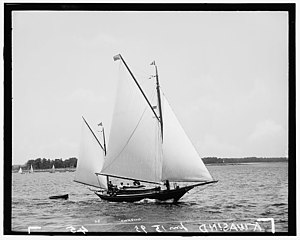
The Sylph was a 19th-century pilot boat first built in 1834, by Whitmore & Holbrook for John Perkins Cushing as a Boston yacht and pilot-boat for merchant and ship owner Robert Bennet Forbes. She won the first recorded American yacht race in 1835. She was a pilot boat in the Boston Harbor in 1836 and 1837 and sold to the New York and Sandy Hook Pilots in October 1837. She was lost in winter of 1857 with all hands during a blizzard off Barnegat, New Jersey. The second Sylph was built in 1865 from a half-model by Dennison J. Lawlor. The third Sylph was built in 1878 at North Weymouth, Massachusetts for Boston Pilots. She was sold out of service in 1901, after 23 years of Boston pilot service.
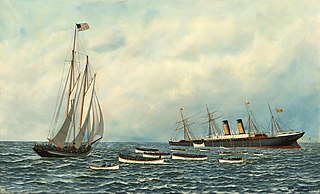
The Phantom was a 19th-century Sandy Hook pilot boat built in 1867 from the designs by Dennison J. Lawlor. The schooner was considered a model for her type with a reputation for being very fast. She helped rescue the passengers on the steamship SS Oregon when it sank in 1886. She was one of the pilot-boats that was lost in the Great Blizzard of 1888. The Phantom was replaced by the pilot-boat William H. Bateman.

The Mary Taylor was a 19th-century yacht and Sandy Hook pilot boat, built at the Hathorne & Steers shipyard in 1849 for Captain Richard Brown. She was designed by George Steers with a new radical design with a long thin bow and wide stern, which made her faster than any other boat in her class. This design proved successful and led to the famous yacht America, which won the America's Cup in 1851. The Mary Taylor sank after colliding with the schooner Fairhaven in 1863. She was replaced by the Mary E. Fish.

The Joseph Pulitzer was a 19th-century Sandy Hook pilot boat, built by Moses Adams in 1894 at Essex, Massachusetts for New York Pilots. She was a replacement for the Pilot Boat Edward Cooper, that sank off Sandy Hook in 1892. The Joseph Pulitzer was one of the finest and best equipped boats in the service. She was named in honor of Joseph Pulitzer, a New York newspaper publisher. In 1896, when New York pilot boats were moving to steamboats, she was sold to the Oregon Pilots Association.
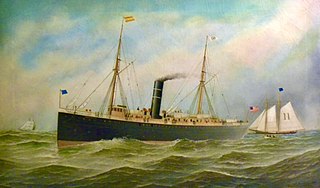
The Ezra Nye was a 19th-century pilot boat, built in 1859 by the Wells & Webb shipyard in Greenpoint, Brooklyn for a group of New Jersey and Sandy Hook Pilots. She was one of the pilot-boats that was in the Great Blizzard of 1888, that was one of the most severe blizzards in American history. In 1896, in the age of steam, the Ezra Nye along with other pilot boats, were replaced with steamboats.

The Edward E. Barrett, or Edward E. Bartlett, was a 19th-century two-masted Sandy Hook pilot boat, built by C. & R. Poillon in 1883 and designed by William Townsend. She helped transport New Jersey maritime pilots between inbound or outbound ships coming into the New York Harbor. She was one of the pilot boats that survived the Great Blizzard of 1888. In the age of steam, the Barrett ended her pilot commission and was sold in 1904.

The Caprice was a 19th-century Sandy Hook pilot boat built in 1871 by Brown & Lovell in East Boston, Massachusetts for Peter McEnany and other New York pilots. In 1876, she was run down and sank, off Bay Ridge, Brooklyn, by the steamship New Orleans. She was raised and was one of the pilot boats that survived the Great Blizzard of 1888. The Caprice was last reported sailing off the coast of New York in 1891.

The David Carll was a 19th-century pilot boat, built in 1885 at the David Carll shipyard in City Island, New York. She was named in honor of David Carll, a well-known City Island shipbuilder. The David Carll was considered to be among the fastest schooners in the fleet. She was built to replace the Mary E. Fish that was run down and sank by the schooner Frank Harrington in 1885. She was one of the pilot boats that survived the Great Blizzard of 1888. The David Carll was lost at sea in 1893.
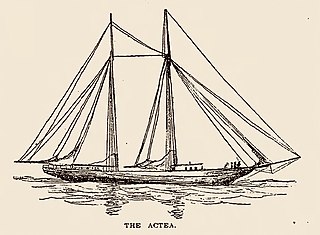
The Actaea, or Actea, was a 19th-century Boston yacht built in 1880 by Weld and David Clark of Kennebunk, Maine for David Sears, Jr., of Montgomery Sears of Boston. She was purchased by a group of New York Sandy Hook Pilots in 1890. She was one of the largest and fastest pilot boats in the fleet. In the age of steam, the Actaea was sold in 1896 to John J. Phelps of the New York Yacht Club and used as a pleasure yacht.
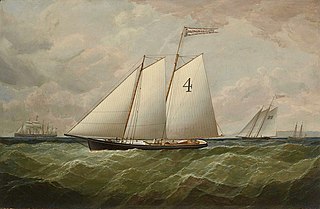
The Abraham Leggett was a 19th-century New York pilot boat built by Daniel Westervelt at the Westervelt & Co. shipyard. She helped transport New York City maritime pilots between inbound or outbound ships coming into the New York Harbor. In 1866, Pilot Michael Murphy was on the Abraham Leggett when the bark Emilie ran into the pilot boat. In 1879, the Abraham Leggett was hit and sank by the steamship Naples from Liverpool. She was replaced by the pilot boat Alexander M. Lawrence.
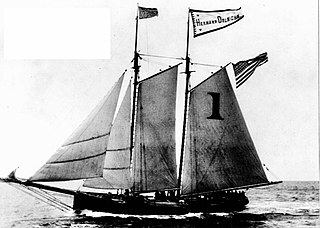
The Hermann Oelrichs was a 19th-century Sandy Hook Pilot boat, built in 1894 by Moses Adams at Essex, Massachusetts for a group of New York Pilots. She helped transport New York City maritime pilots between inbound or outbound ships coming into the New York Harbor. The Herman Oelrichs was said to be the fastest of the New York pilot fleet. She was built to replace the pilot boat Hope, that was wrecked in 1890.

The Friend was a 19th-century pilot boat built by Daniel D. Kelley & Holmes East Boston shipyard in 1848 for Boston pilots. She helped transport Boston maritime pilots between inbound or outbound ships coming into the Boston Harbor. The Friend was one of the last of the low sided, straight sheared schooners built in the 1840s for Boston pilots. The second Boston pilot boat Friend was built in 1887. Her name came from the older Friend that was in the service in the late 1840s. Captain Thomas Cooper sold the Friend to New York pilots in 1893. Cooper replaced the Friend with the pilot-boat Columbia in 1894.

The Mary E. Fish was a 19th-century Sandy Hook pilot boat, built at the Edward F. Williams shipyard of Greenpoint, Brooklyn in 1861 for Richard Brown and the New York Pilots. She was built to replace the Mary Taylor. The Fish was hit and sank by the schooner Frank Harrington in 1885 and replaced by the David Carll.

Charlotte Webb was a 19th-century New York City pilot boat built in 1865 at the Webb & Bell shipyard to take the place of the James Funk, that was destroyed by the rebel Tallahassee during the Civil War. She survived the Great Blizzard of 1888, but was run down by the French steamship La Normandie in 1889. She was replaced by the pilot boat George H. Warren.
The James Gordon Bennett was a 19th-century two-masted pilot boat, built in 1870 at the Lawrence & Foulks shipyard. She was named in honor of James Gordon Bennett, Jr., publisher of the New York Herald. She went ashore in 1893 and was rebuilt at the C. & R. Poillon shipyard. In 1897, the James Gordon Bennett was bought by Miller J. Morse of the Atlantic Yacht Club and made into a yacht. He changed her name to Hermit. The New Jersey pilots purchased her in 1901, to replace the David T. Leahy, that was run down by the steamship Alene. The Hermit sank in 1906, when the steamship Monterey ran into her.

The Coquette was a 19th-century yacht and pilot boat, built in 1845 by Louis Winde, at the Winde & Clinkard shipyard in Chelsea, Massachusetts for yachtsmen James A. Perkins. Her design was based on a model by shipbuilder Dennison J. Lawlor. The Coquette was a good example of an early American yacht with a clipper bow. As a yacht, she won the attention for outsailing the larger New York yacht Maria at the second New York Yacht Club regatta in 1846. Perkins sold the Coquette to the Boston Pilots' Association for pilot service in 1848. She continued as a pilot boat until 1867 when she was sold as a Blackbirder to be used on the African coast.

The George H. Warren was a 19th-century pilot boat built in 1882 by Porter Keene at Weymouth, Massachusetts, to replace the Edwin Forrest, No. 4, which was sold to the Pensacola, Florida pilots. The George H. Warren, originally belonged to the Boston pilot fleet but in 1889, she was purchase by a group of New York pilots. She and her crew were lost in the great blizzard of 1895.

Thomas D. Harrison was a 19th-century New York pilot boat built for New Jersey pilots. She was launched from the Jacob S. Ellis & Son shipyard, at Tottenville, Staten Island in 1875. The Harrison went ashore in the Great Blizzard of 1888 with no lives lost. She continued as a pilot boat with Pilot Stephen Cooper in command. She was purchased in 1897 by Allerton D. Hitch and used for coastal trade in the Cape Verde islands off the west African coast.
Ambrose A. Martin, was a 19th-century Boston, Massachusetts yacht and boat shipbuilder. He built the Ambrose A. Martin shipyard in 1882 at Jeffries Point, East Boston, where he built many notable Boston yachts and schooners. Martin died in Boston in 1934.
